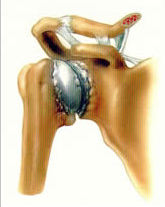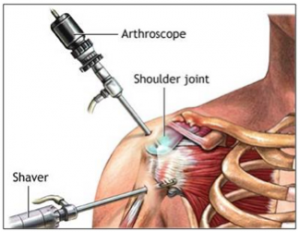Arthroscopic debridement and resurfacing of the glenoid joint is a form of shoulder surgery. The glenoid is a part of the scapula (shoulder blade) is a shallow, articular surface located on the lateral aspect of the scapula. Debridement is the process of removing debris, excessive tissue, loose bodies, and other structures from the shoulder joint.
What are the components of the shoulder joint?
The complex shoulder joint is made of three bones: the clavicle (collarbone), the humerus (upper arm bone),  and the scapula (shoulder blade). The head of the humerus fits into the rounded socket of the scapula, which is called the glenoid. Around the glenoid is strong, fibrous cartilage (labrum), which forms a gasket around the socket, cushions the joint, and provides joint stability.
and the scapula (shoulder blade). The head of the humerus fits into the rounded socket of the scapula, which is called the glenoid. Around the glenoid is strong, fibrous cartilage (labrum), which forms a gasket around the socket, cushions the joint, and provides joint stability.
What type of anesthesia is used in the procedure?
The shoulder arthroscopic procedure with a Scottsdale orthopedic surgeon can be performed using one of two forms of anesthesia:
- General anesthesia – You will be unconscious and not able to sense pain.
- Regional anesthesia – Your arm and shoulder will be numb so you do not experience any pain in these areas.
Why is the procedure performed?
Resurfacing of the glenoid and debridement is done when the patient has severe shoulder pain, decreased arm mobility, loss of shoulder function, shoulder weakness, and/or stiffness of the shoulder joint. Causes of these symptoms include:
- Rheumatoid arthritis
- Osteoarthritis
- Bad results from a previous shoulder procedure
- Tumor around or in the shoulder
- Torn or damaged tissues of the shoulder
How do I prepare for the arthroscopic debridement and resurfacing of the glenoid?
 Before the procedure, you need to notify the Tempe orthopedic surgeon of your medications. Because they increase bleeding, certain medicines must be held, such as aspirin, blood thinners, and nonsteroidal anti-inflammatory agents. Discuss your medical conditions with the doctor, and make sure he is aware of how much alcohol you consume each day.
Before the procedure, you need to notify the Tempe orthopedic surgeon of your medications. Because they increase bleeding, certain medicines must be held, such as aspirin, blood thinners, and nonsteroidal anti-inflammatory agents. Discuss your medical conditions with the doctor, and make sure he is aware of how much alcohol you consume each day.
What happens on the day of surgery?
You are asked not to eat or drink for 8 hours before the surgery. However, you are permitted to take necessary medications with sips of water. When you arrive at the surgical center, a nurse will go over the procedure risks and benefits and have you sign a form of informed consent. After you change into a gown, the nurse places an IV line in your arm and preps your shoulder area.
How is the procedure performed?
Once anesthesia is given, small incisions are made around the shoulder area. The surgeon flushes the area with saline to improve viewing. A small, lighted camera is inserted through an incision. Small tools are used to remove loose bodies and debris and make repairs the glenoid. Once the tools and camera are removed, the incisions are closed with sutures, and a bandage is applied.
What happens after the procedure?
After the surgery, you are moved to a recovery room where a nurse monitors you for 45 minutes. Most patients stay in the hospital overnight, but depending on your condition, the extent of the repair, and the Arizona shoulder surgeon’s preference, you may have to stay overnight. Your arm will remain in a sling for 2-6 weeks, with no movement. You will begin to work with a physical therapist who teaches you exercises for strengthening and flexibility.
Is the arthroscopic debridement and resurfacing procedure effective?
In a recent clinical study, 72% of patients with glenohumeral osteoarthritis reported pain relief and functional improvement.
Resources
Arthroscopic debridement and biological resurfacing of the glenoid in glenohumeral arthritis. Knee Surg Sports Traumatol Arthrosc. 2010 Dec;18(12):1767-73. doi: 10.1007/s00167-010-1155-8. Epub 2010 May 18.



